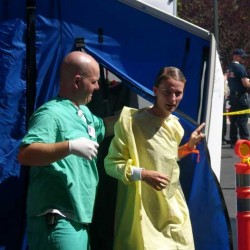USU students play disaster victims, help emergency responders learn
September 12th, 2011 Posted in OpinionStory and photo by April Ashland
LOGAN–Logan Regional Hospital hosted a disaster drill Saturday morning, simulating an explosion at an LDS ward house on the southeast side of the hospital. On scene were Logan City Fire Department, Cache County Sheriff’s Office, Logan Police, North Logan Fire Department and members of the Bear River Health Department.
 In the scenario, 13 people were injured in a pesticide-based explosion. The cause was unknown. Eight patients arrived at the hospital on foot and were sent through decontamination outside the emergency room, and five arrived by emergency transport and Cache Valley Transit, according to the hospital’s Public Information Officer Julie Sanders.
In the scenario, 13 people were injured in a pesticide-based explosion. The cause was unknown. Eight patients arrived at the hospital on foot and were sent through decontamination outside the emergency room, and five arrived by emergency transport and Cache Valley Transit, according to the hospital’s Public Information Officer Julie Sanders.
Sanders gave five faux press conferences, in which the three press organizations that attended the disaster drill received information and asked questions.
Utah State University students played the victims, and were gathered by USU Emergency Manager, Judy Crockett. Crockett said she gathered the students from the USU Housing program as well as local wards.
One such student, Emily Decker, works for housing, and signed up to volunteer at housing training. She said she was happy to volunteer, because it helps in the case of an emergency.
“It’s good practice in case of an emergency,” she said. “We play a role, and if they get something wrong, then they learn from it.”
Mike Clark, CEO of Logan Regional Hospital, said the hospital learned very important lessons from the drill. “We learned things take time, and that communication is always an issue,” he said.
Many of the “victims” arrived on foot, and were sent to the ER. The ER then sent the individuals around to another door. The individuals were assisted through a decontamination shower by nurses and Hazmat. Hazmat individuals were then showered off themselves.
One such individual was Travis Burton, a member of the Logan City Fire Department. Burton said he liked the drill, and thought it was a positive experience for everyone involved. “The structure is important,” he said. “Creating the communication between everybody is what we learned today.”
The drill was to help the organizations prepare for a disaster, as well as to improve procedure, Clark said.
“There’s a lot in common with the event we did (and what could happen), but we can’t predict everything,” he said. “We saw our weaknesses and strengths, and we work to improve both.”
Clark said there were some things that the hospital couldn’t do, like call in doctors who would normally work an event such as this, and all who participated were volunteers.
“We had to call in a social worker, so we had someone act out that part,” he said. “We couldn’t call in doctors, because we would have had to pay them salary.”
Since the participants were volunteers, the cost of the drill was rather small, Clark said. “Victims” received a cookie after participating.
Austin Wilkins, a student at Utah State who participated in the drill as a victim, said he thought it went rather well. “They did a good job,” he said. “It was a lot of fun, and I’d trust them to clean me off.”
Many of the employees that worked the drill were new to the procedure, and some to the hospital. One such employee, Christina Roberts, was using the event not only as an interesting experience, but to gain knowledge.
“It’s an opportunity to get training, in something I don’t have a lot of experience in yet,” Roberts said. Roberts assisted the press in getting to various areas of the drill in order to cover the event, as well as to assist in the drill as press.
The drill was made as realistic as possible, she said, by having some things remain a mystery to employees and drill participants.
“We were told to turn our phones on at 10 to keep it as real as possible,” Roberts said. “We wouldn’t really know what was happening if this was a real event.”
NW
Tags: disaster drill, emergency planning, Logan Regional Hospital

One Response to “USU students play disaster victims, help emergency responders learn”
By Troy Oldham on Sep 12, 2011
Having the USU journalist students participate made the event very real. We love having USU students involved, thanks JCOM Department, Dr. Ted Pease and the Utah Statesman (Jay Wamsley).